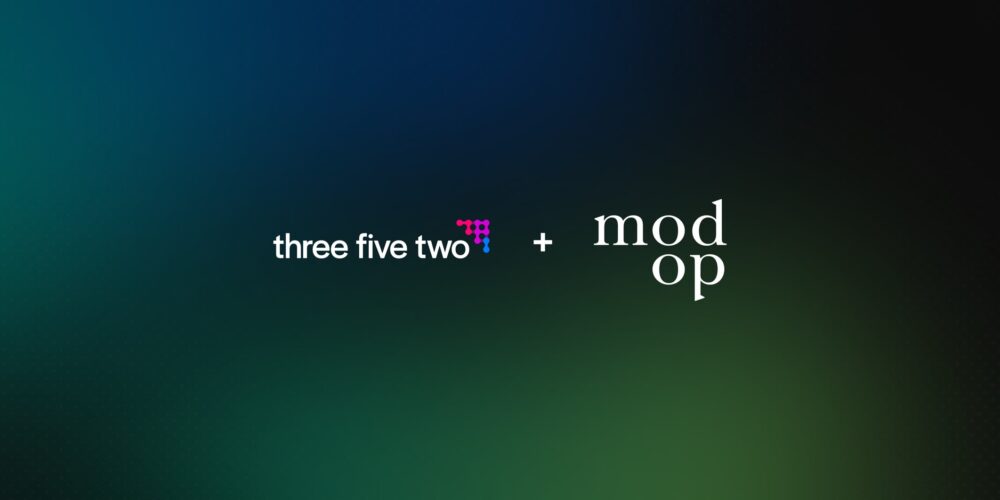
The Legacy Challenge: Responding to Disruption
Atlanta Financial Leaders Discuss the Impact of Disruption and Need for Corporate Agility
Connectivity and collaboration are of critical value to Atlanta’s innovation community. Leaders seek each other out across industries, recognizing the importance of experience and insights lived outside one’s category in pursuing growth. To foster these conversations, Three Five Two regularly invites leaders to come together and talk about current challenges as part of its Executive Huddle series.
Three Five Two recently hosted an intimate discussion among current and former executives from US Bank, Truist Bank, Momnt, and NCR. Facilitated by Three Five Two’s Robert Berris, EVP and managing director, the conversation also included Three Five Two’s Stephen Borengasser, SVP of practitioner enablement, Mario Antwine, VP of growth, and Justin Liebstueckel, senior manager of financial services at Porsche Consulting.
Surrounded by colorful, shiny sports cars, we gathered at the inspirational Porsche Experience Center in Atlanta to unpack the topic of The Legacy Challenge and how outdated, or inefficient processes, organizational structures, systems, and technology constrain a company’s growth. Why this topic? McKinsey suggests legacy business challenges are negatively impacting “speed to market, customer satisfaction, and employee engagement” by as much as 70 to 80 percent. So, this group came together to share how they are tackling these barriers to corporate growth.
Breaking the Ice
We know the faster we get into candid conversation, the better. So we leveraged Catalyst Cards, created by our beloved colleague Rich Goidel, to give participants a creative constraint for how to enter a generative dialogue.
Each card contains a prompt that participants associate with a metaphor for their personal experiences within The Legacy Challenge. This activity is brilliant for lowering everyone’s guard and getting them to open up fast, which is no easy feat in a room of strangers. Once started, the conversation never slowed down.

The Catalyst Cards exercise prompted several conversations:
- Like a tree‘s deep roots, legacy systems entangle themselves in an organization, slowing decision-making and operational agility
- Companies face a never-ending line of both anticipated and unanticipated disruptive events or threats that may feel like ticking time bombs (i.e. Y2K vs. the Covid Pandemic)
- Market and customer trends can often feel like ocean currents, taking an industry or company in a new direction that it must either embrace or risk subsequent consequences
Responding to Time Bombs
Energy grew during a discussion about major events that present themselves with little warning and can significantly impact their companies’ growth. The questions arose: How do you lead through change once you finally see what’s happening?
A Big Win
One participant shared about quickly responding to an unanticipated market need. As a financial institution offering business loans, the passage of PPP Loan legislation in response to the Covid-19 pandemic threatened an unprecedented spike in demand on the company’s web infrastructure from customers applying for loans online.
The organization had been slow to move to the cloud, but they now had the business case, a viable solution, and an implementation plan to drive the change. This executive was able to influence a massive change in a short amount of time.
Their Legacy Challenge was twofold – not only would the company have to shift to new technology, but they would also need to build partnerships across the company to overcome inertia and influence change in corporate ‘current.’
Borengasser pressed them to share how they influenced the CEO, to which they replied, “I used data.” They built a business case that was empathetic to the CEO’s needs and backed by data, allowing the company to tackle this big opportunity.
“This executive used a handful of simple, but incredibly powerful techniques that – when combined – drove the change they needed. Empathy, quantitative data, assessment of ego, a logical argument, and clear implications to their business should they do or not do this change. They designed their argument to the person and the situation they were in, knowing how they might react. While someone might argue, this is the foundation of structuring a presentation or argument, you generally don’t learn this without having failed… a lot in the past. Many times driving change an innovation relies upon these techniques far more than a framework like design thinking.” – Robert Berris, EVP & managing director, Three Five Two
The Importance of Operational Agility
In this executive’s situation, their organization could not have predicted that legislation could flood its infrastructure with website visitors, making it unable to respond to the needs of its customers. It wasn’t a planned decision that the organization could allocate budget toward or spend time experimenting in R&D.
For businesses to respond to unforeseen disruptions, operational agility must exist.
But what does it mean to be an agile organization? Operational agility must be part of a company’s culture, woven through its leadership, operations, and teams. It is a capability and expertise where individuals and teams all over the organization understand how to quickly plan for and quickly respond to an unforeseen event, even if it means acting differently from their day-to-day responsibilities.
As we dove deeper into the topic, it was clear that each of these executives related to working at companies, past and present, that contained few people who can act under these circumstances. Why? Because the core business will focus on operating within the design and constraints of the current way the business runs. And as such, few companies train their teams and prepare them to operate in uncertain times.
Nearly every executive in the room could relate to the Legacy Challenge involving a lack of agility. Stephen Borengasser, SVP of practitioner enablement at Three Five Two shared a personal experience from a former role where his team needed to operationalize manufacturing a new CPG product. The company had invested approximately $200M in R&D. The product was also tested in customer research, and enough evidence existed to support a premium price point. With a production plan in place, a massive shipment was sold to a major retailer.
The team met production timelines and shipped the product to shelves on time. Despite the investment in R&D and consumer testing and research that demonstrated customer preference for the product’s premium features, customers wouldn’t pay the premium price for the product when given the choice. The result was a massive revenue loss for the company, catching leadership completely unprepared.
“There are a lot of things that have to be in place to be good at bringing new things to market. Where it starts is, there has to be some level of an experimental mindset.”
Stephen Borengasser
SVP of practitioner enablement @ Three Five Two
Stephen continued, “Companies must be willing to put things in market quickly and learn in market versus spending a lot of time talking about what might happen in the planning phase, or spending a lot of time in the development phase without market feedback. If that experimental mindset isn’t there, it becomes very difficult to do everything else you need for it to be successful.”
A Path Ahead
The in-depth dialogue at the Executive Huddle on The Legacy Challenge highlighted how important it is to act fast during times of disruption. Stories from attendees revealed how data, when used effectively, can help drive decision-making and successfully spur change. Additionally, empathy should be at the center of any strategic plans. All in all, leaders can create their own personal toolkit to quickly face changes head-on and ultimately lead with confidence.




